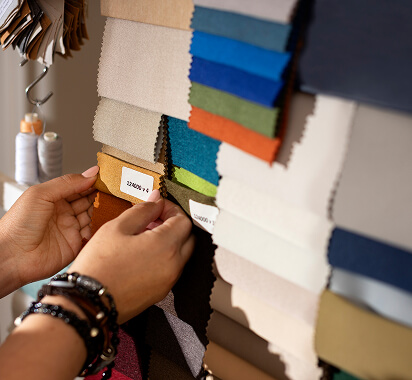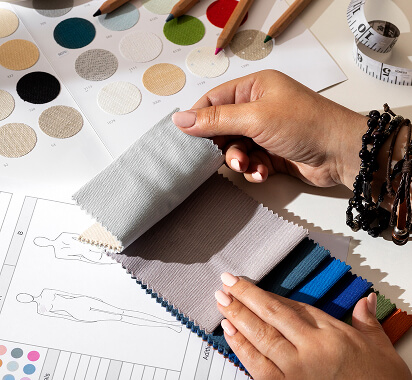
-
By admin
-
October 22, 2025
- 0 Comment
How to Choose the Right Fabric Material for Your Garments: The White Horse Guide.
Fabric goes far beyond being just a “material” for fashion, it is the backbone of every garment, setting the stage for shape, comfort and beauty. As a designer, knowing your fabrics is important to ensure that your clothes look and feel the way you want them.
As custom clothing manufacturers, we’ll explore how fiber fabrics are made, why certain weaves work best for certain styles, and which properties (like weight or drape) matter when you’re imagining a new design. Choosing the right fabric for your clothing design has the same importance as choosing a foundation for a building, if you get it wrong, the entire project can fail. Whether you’re crafting a light summer outfit or a structured winter coat, understanding how to select the right material can make a big difference.
Understanding Different Types of Fabric Materials
Selecting the best fabric for clothing depends on the type of clothing you plan to produce and your specific requirements for appearance, comfort, and functionality. There are two types of fabrics; grey fabric and finished fabric. Generally the garment is made from ready-made cloth. Every one of us wears clothes made of different types of fabrics. The most common types of fabrics used for garments are cotton voile, cotton lawn, rayon challis, chambray, denim, double gauze, knit, silk, satin, linen, wool, flannel, etc. Each has a unique experience and purpose in the world of garments.


Consider the Purpose of the Garment
Here are the main purposes of garments in the garment industry, summarized in clear points:
Protection:
Garments shield the body from environmental factors such as heat, cold, rain, dust, and harmful UV rays.
Modesty:
Clothing helps individuals maintain cultural, social, and personal standards of decency.
Comfort:
Properly designed garments ensure ease of movement, breathability, and overall comfort in daily activities.
Aesthetics and Fashion:
Garments allow people to express personal style, creativity, and current fashion trends.
Identity and Status:
Clothing often signifies profession, social status, cultural background, or group belonging.
Functionality:
Specific garments serve specialized purposes like uniforms, sportswear, or protective workwear.
Economic Value:
Garment production fuels the textile and fashion industries, generating jobs and trade opportunities.
Cultural Representation:
Traditional garments preserve and promote cultural heritage and regional identity.
Matching Fabric to Garment Style
- It’s important to understand that different factors in fabric choice can make your garment look and feel completely different!
- Start by knowing what your garment is for. Choose a fabric that matches style, comfort and use. Always test your fabric first. Check how it shrinks, stretches and feels after washing.
- It can be really beneficial to get samples of two different fabrics to get an idea of what you want from your garment and which fabric you like best.
- Choose good quality and eco-friendly clothes.
- Test different types and see what works best for your ideas. The more you discover, the better your designs will be. Good fabrics make great fashion. Keep learning and experimenting.
Common Mistakes to Avoid When Choosing Fabric
Ignoring the use of clothes
One of the biggest mistakes in fabric selection that many designers make when choosing is that they ignore the weight and drape of the fabric. Lightweight chiffon is excellent at making flowing dresses, but falls short for upholstered or structured garments. It’s essential to match the properties of the fabric with the needs of your project – prioritize durability for upholstery and breathability for fabrics. Choose wisely to get best results. For example, when selecting fabric for a summer dress, if one selects a heavy fabric, the dress may turn out stiff and uncomfortable. On the other hand, choosing lightweight fabric for a structured coat means that the final product will be flimsy and look poorly fitted.
The weight, fabric and design of the fabric are one of the most important aspects that any designer needs to consider while choosing the fabric for producing clothes.
Neglecting fabric care instructions
Some fabric, like cotton, wool, and linen materials, are acknowledged to shrink, especially after the initial time that one washes them. Lack of consideration concerning fabric shrinkage at some point of the selection technique would simplest cause clothes with terrible suits, a shrunken appearance, and typically poorly made clothes after washing.Many shoppers forget about assessing the colour fastness of fabric, specifically after they plan to clean or divulge them to daylight. Considering this aspect ensures that the fabric keeps its vibrancy and integrity over the years.
Fabric Selection Tip: Wash your material and dry it earlier than the use of, slicing, and sewing because the material may additionally shrink.
Not considering fabric weight
The weight and thickness of the fabric plays an important role in the success of your project. Different projects demand specific weights, and ignoring this aspect can result in garments that fall short of their intended purpose. The heaviness of a fabric has a profound effect on its drape, shape, and overall performance. For example, adding heavy denim to the summer tops may indicate discomfort and heat-stroke, while adding light, airy voile as curtains may lack the support and opacity they require. Dive into our collection to ensure that your creations are perfectly balanced in both aesthetics and functionality.
Conclusion
Selecting fabric is simple, but not making these mistakes can save you money, time, and frustration. These mistakes in fabric selection testify to the fact that mistakes made in fabric selection can lead to a variety of problems, like, for example, ill-fitting look and structure followed by discomfort, poor durability, easy tearing and the need for extensive care. Considering these fabric selection tips ensures that you get great fabrics that are not only beautiful but also durable. The above five fabric selection mistakes are common in many garment companies: If you avoid the above mistakes, the quality of products will increase, Therefore, customer returns will be reduced. After all, fabric selection is the first step when sewing an excellent piece of clothing.

